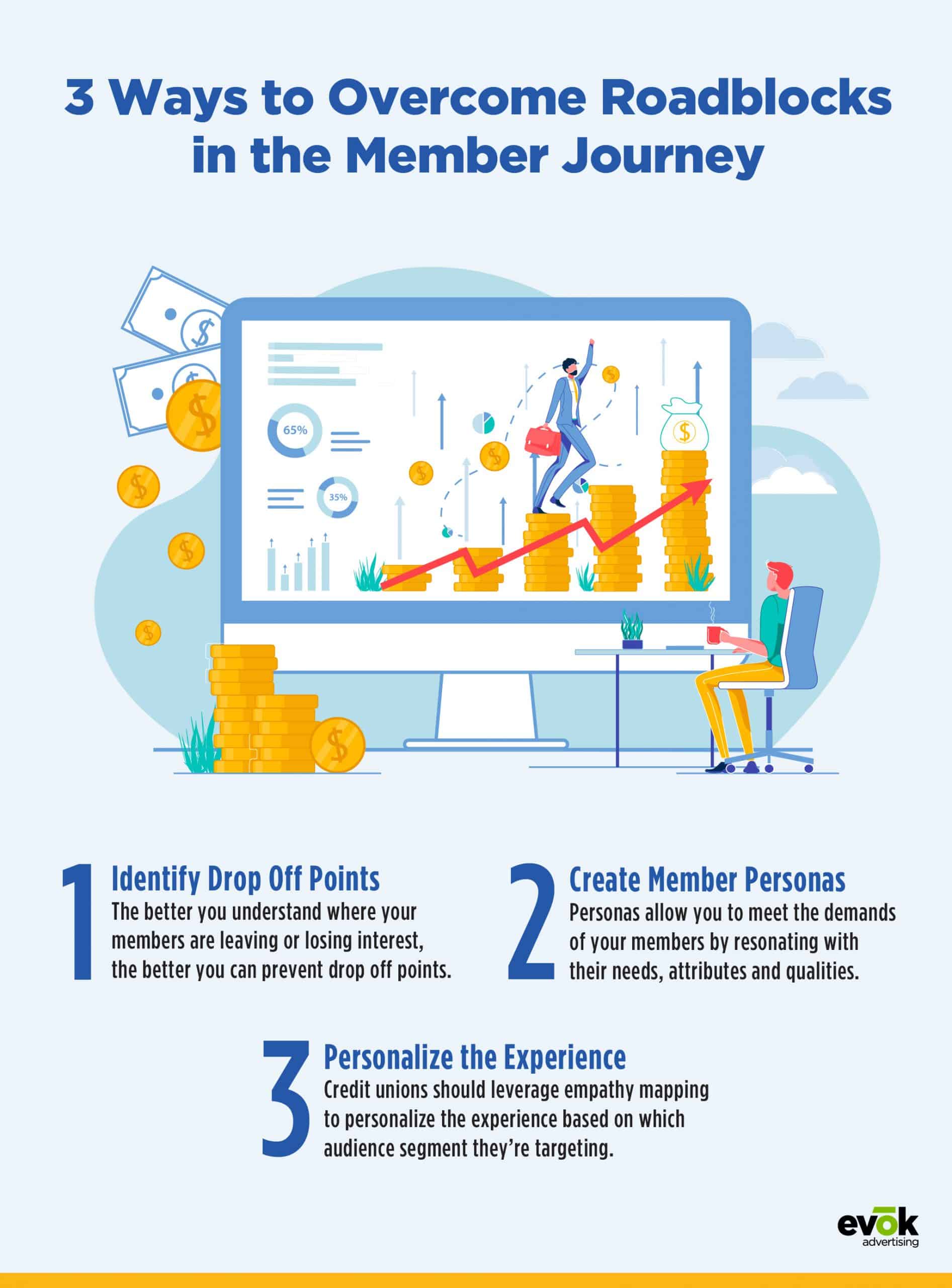
Improving Member Journey Mapping for Your Credit Union

Member demands are always evolving, especially in today’s climate. Credit union marketers are challenged with the responsibility of rerouting the member journey to reach the last phase of the cycle, otherwise known to be brand advocacy. The member journey targets all the touchpoints a prospective or current member might come across with your credit union, starting from the moment they’re introduced to your brand. But to guide them toward the final phase, you must keep them on the right path and fix any roadblocks along the way.
Understanding the Phases of the Member Journey
Before you can pick out any flaws or pain points in your member journey, you should first understand the phases. The member map puts marketers in their members’ shoes and allows them to follow their experience from start to finish. Here’s what you can expect in each of the five phases of the journey.
Brand Awareness Phase
The member journey begins with awareness. At this phase, a prospective is not interacting with your brand but rather just acknowledging it. Whether they noticed your billboard during their commute to work or they came across your social media pages while scrolling their feed, this is a small step toward getting prospects comfortable and acquainted with your brand.
Consideration Phase
The consideration phase is filled with moments of learning to trust a brand based on the information at hand, including rates, online reviews, and what differentiates one credit union from another. Prospective members use this time to review your website, social media channels, and online reviews to understand if your services will fit their needs, so it’s rather important to instill trust during this phase of the journey.
Purchasing Phase
Next on the journey comes the purchasing phase, in other words, the phase where you secure a new member or increase your conversion rate. This phase follows crucial moments of the process, from filling out a new member application to helping with onboarding. This phase can share some insightful data about your member journey. For example, if a member abandoned their application halfway through, it can stir some questions as to why they didn’t finish. Data insights can further answer these questions and help you refine the process for a better success rate in return.
Retention Phase
Earning the trust of members is what allows you to retain them. So, how does your credit union keep members interested, engaged, and overall satisfied? The answer to these questions can ultimately determine whether your members continue to utilize their membership benefits or look to somewhere else for their banking needs. Credit unions retain members through convenience, personalization, and engagement, whether it’s through emails, online banking tools, or special offers and giveaways.
Brand Advocacy Phase
Last but not least, the member journey reaches a peak at the brand advocacy phase. This means that giving your members an outstanding experience has its perks beyond just gratification – it means it can lead to better feedback, online reviews, and social posts. A loyal member of a brand is eager to spread the word and share the same experiences they’ve had with others. That’s why the member journey should encompass more than simple transactions, and it should move your members to spread the word.
Resolve Pain Points or Roadblocks
Understanding the member journey is only the beginning. Finding ways to improve it is more important. At this point of the process, you should be analyzing your data and finding pain points that might deter a member from reaching the final phase. While the ultimate goal is to provide every member with an exceptional and personalized experience, the reality is that not everyone will agree. Here a few ways to better target your current and prospective members and create a seamless sales funnel.
Identify Drop-Off Points
The journey is long, and it could take years to reach the brand advocacy phase for some. While it’s inevitable to save everyone from dropping off the map, it’s certainly possible to seal the cracks and keep many moving forward. This takes a better understanding of your pain points and where members are losing interest. For example, if one lands on your website’s auto loan page but doesn’t follow through with an application, maybe your rates aren’t competitive enough, or your website design needs to be more user friendly. An in-depth analysis of drop-off points can help you patch the holes and create a smoother route.
Create Member Personas
Member personas help you tailor the journey to your audience and allow you to meet your consumers’ demands by resonating with their needs, attributes, and qualities. With big data, credit union marketers can produce relevant content and messaging that resonates with certain audience segments beyond a surface level. Generally, for credit unions, member personas focus on demographics like age, marital status, annual income and can dive deeper into lifestyle specificities like where they shop, what type of car they drive and what they like to do during their downtime. The better you know your audience, the easier it is to keep them engaged.
Personalize the Experience

A personalized experience is no longer an option in the credit union space, and it’s a necessity. From digital touchpoints that help members streamline their finances on the go to providing exceptional customer service when help is needed, a marketer’s strategy should highlight these tactics to keep members wanting more. Credit unions can leverage empathy mapping to personalize the experience based on the audience segment. For example, while a B2C consumer might be concerned about home loan rates, a B2B consumer would be more interested in business loans or services. This type of insight helps you categorize your personas and personalize the journey accordingly.
A member journey map is a supporting tool for nearly every tactic in a credit union marketing strategy. With a clear understanding of the phases and a visual representation to accompany them, marketers can strengthen the member experience by eliminating pain points and focusing on the key touchpoints. Through an actionable, measurable, and powerful member journey map, you can set your credit union on the path toward long-term success.
Want to hear more from our credit union marketing agency? Sign up for our credit union newsletter for monthly insights on acquiring and retaining new members, how consumers choose financial institutions, and what’s trending in credit union marketing.